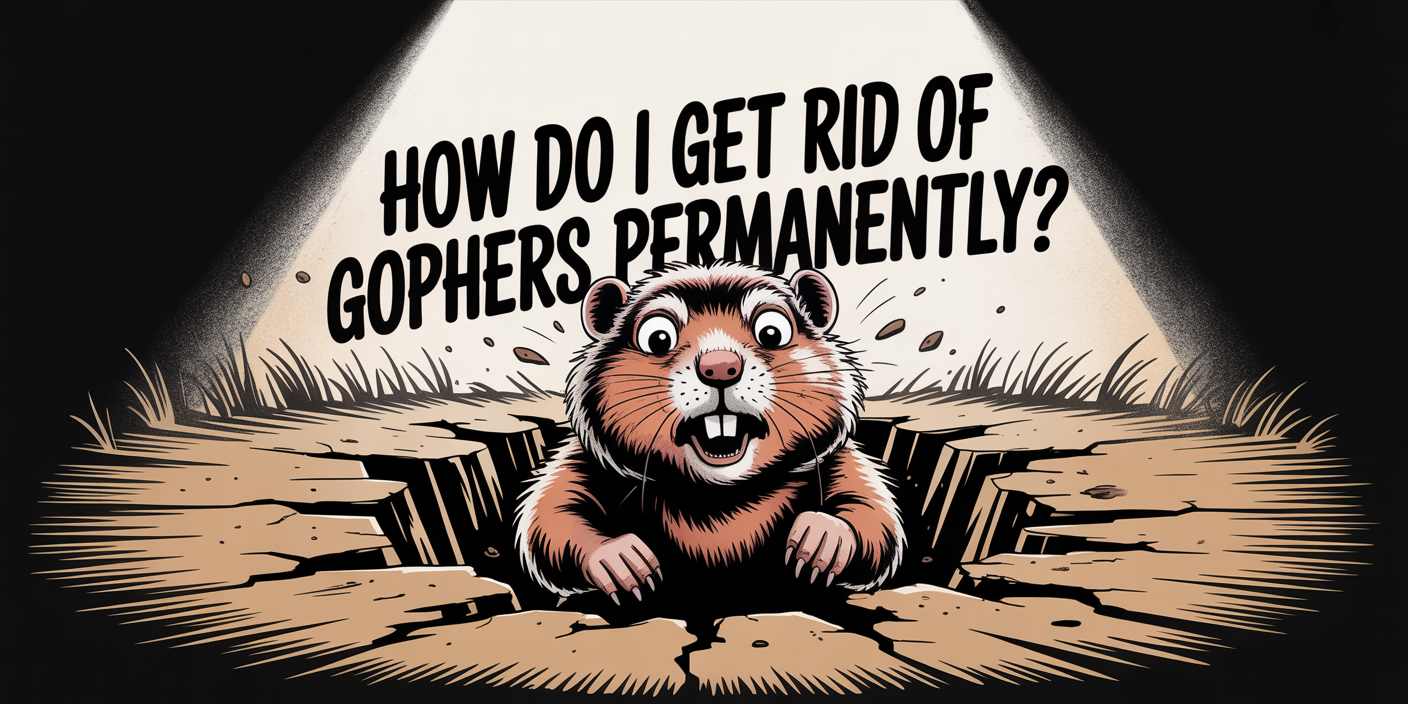To get rid of gophers permanently, you need to combine strategic trapping with long-term habitat modification. This means setting traps in active tunnels while also removing food sources and installing underground barriers to prevent future infestations.
Gophers can quickly turn a peaceful lawn into a frustrating mess of dirt mounds and underground tunnels. Their constant digging not only ruins your landscaping but can also damage irrigation systems, roots, and other parts of your property. If you’ve already tried repellents, noise devices, or other DIY tricks with no real results, you’re not alone.
That’s where AAAC Wildlife Removal comes in with professional gopher removal services that actually work. Their experts use proven techniques to eliminate gophers efficiently and prevent future invasions, giving you back a clean, healthy yard without the guesswork.
Learn more: What do gophers hate the most?
What Attracts Gophers to Your Yard?
Gophers are drawn to yards with soft, moist soil that makes tunneling easy. Lawns with abundant roots, bulbs, vegetables, or ornamental plants offer a buffet of food sources that gophers can’t resist, especially if irrigation keeps the ground consistently damp.
They also prefer open, quiet areas with minimal foot traffic or disturbance. If your yard offers shelter, food, and ideal soil conditions, gophers are likely to settle in and start building their tunnel networks fast. Removing these attractants is a crucial first step in stopping them for good.
How Do You Know If You Have a Gopher Problem?
The most obvious sign of a gopher infestation is the presence of crescent-shaped mounds of dirt scattered across your yard. These fresh mounds usually have no visible hole, as gophers plug the openings to protect their tunnels, which run deep underground and can span large areas quickly.
You might also notice wilting plants, missing roots, or entire flowers disappearing into the ground. Unlike moles, gophers feed on vegetation and root systems, causing significant damage to gardens and landscaping. Catching these signs early helps you take action before the infestation grows out of control.
What Are the Most Effective Ways to Get Rid of Gophers Permanently?
Use Underground Traps Strategically
Trapping is the gold standard for long-term gopher control. Box traps, cinch traps, or Macabee traps should be placed directly into the main tunnels, which are usually located 6 to 12 inches below the surface. When set correctly and monitored daily, traps can effectively eliminate active gophers within days.
It’s important to wear gloves when handling traps to avoid transferring human scent, which can make gophers cautious. After catching a gopher, reset the trap until no new activity or mounds appear. This method is especially effective in small-to-medium infestations.
Deploy Carbon Monoxide Exhaust Systems
Carbon monoxide machines, often used by professionals, pump gas into tunnel systems and eliminate gophers in a more passive, hands-off way. This is particularly helpful when trapping isn’t practical or when dealing with multiple tunnels across a wide area.
Because this method targets the entire underground network, it prevents gophers from escaping to other parts of your property. It’s most effective when combined with trapping and is ideal for recurring infestations or when time is limited.
Do Gopher Repellents Actually Work?
Most over-the-counter gopher repellents provide only temporary relief, if any at all. Castor oil-based products, garlic spikes, and ultrasonic devices might drive gophers away for a few days, but they typically return once the scent fades or the noise becomes familiar. These methods don’t target the root cause or remove the gopher from your yard, making them unreliable as long-term solutions.
Natural repellents can be useful as a supporting tool alongside trapping and habitat changes, but they’re rarely enough on their own. Gophers are highly territorial and driven by food, so unless you take away their motivation to stay, they’ll likely ignore most deterrents. For real, lasting results, repellents need to be part of a broader strategy—not the main approach.
Can You Prevent Gophers from Coming Back?
Yes, and prevention is where long-term success really happens. Start by removing what attracts gophers in the first place: overwatering, dense vegetation, and easily accessible root crops. Dry soil, minimal food sources, and consistent foot traffic can make your yard much less appealing to them. You can also install underground wire mesh (hardware cloth) beneath garden beds, sod, and planter boxes to physically block gophers from tunneling up.
Another smart tactic is gopher-proof landscaping. Choose plants they tend to avoid, like daffodils, lavender, or marigolds, and avoid laying down thick mulch or compost piles that make tunneling easier. If your lawn or garden has previously been infested, regular inspections and preventive maintenance each season will go a long way in keeping gophers from returning.
Are Gopher Poisons a Safe Option?
While gopher poisons are available, they come with serious risks that often outweigh the benefits. Most poisons pose a danger to pets, children, and non-target wildlife like birds, owls, or neighborhood cats that might ingest a poisoned gopher. In many areas, their use is heavily regulated or outright banned due to the environmental hazards they create.
Even when legal, poisons don’t guarantee a permanent fix. Gophers may die deep in their tunnels, leaving you unaware if the problem is resolved—or worse, creating odor or sanitation issues underground. More importantly, poisons do not prevent new gophers from moving in. For lasting, responsible control, physical removal and habitat modification are safer and more effective.
How Long Does It Take to Get Rid of Gophers for Good?
The timeline depends on the severity of the infestation and the method you choose. With proper trap placement in active tunnels, you can start seeing results within 48 to 72 hours. For single gophers or small problems, a week of consistent trapping is often enough to fully clear them out.
Larger infestations or yards with ideal gopher habitat may take several weeks to fully resolve. Follow-up inspections and retreatments are crucial, especially if you’re using multiple methods like trapping, habitat changes, and carbon monoxide devices. The key is persistence—gophers are stubborn, but with consistent effort, permanent removal is completely achievable.
AAAC Wildlife Removal Handle Your Gopher Problem for Good
Tired of fighting gophers on your own? AAAC Wildlife Removal offers professional, humane, and effective gopher control that targets the root of the problem. Our trained technicians don’t just treat the surface—they inspect, trap, and implement long-term prevention strategies tailored to your property.
Don’t wait until your lawn looks like a minefield. Call AAAC Wildlife Removal today for a free assessment and let us restore your yard—safely, quickly, and permanently.
Conclusion
Getting rid of gophers permanently takes more than a quick fix—it requires a combination of proven methods and long-term strategy. Trapping and carbon monoxide treatments offer immediate results, while habitat modification helps ensure they don’t come back. Relying on repellents or poisons alone won’t cut it if you’re aiming for lasting control.
The good news? With consistency and the right tools, you can reclaim your yard for good. Whether you take the DIY route or call in professionals, the key is to act early, stay persistent, and prevent reinfestation through smart landscaping and regular monitoring.




